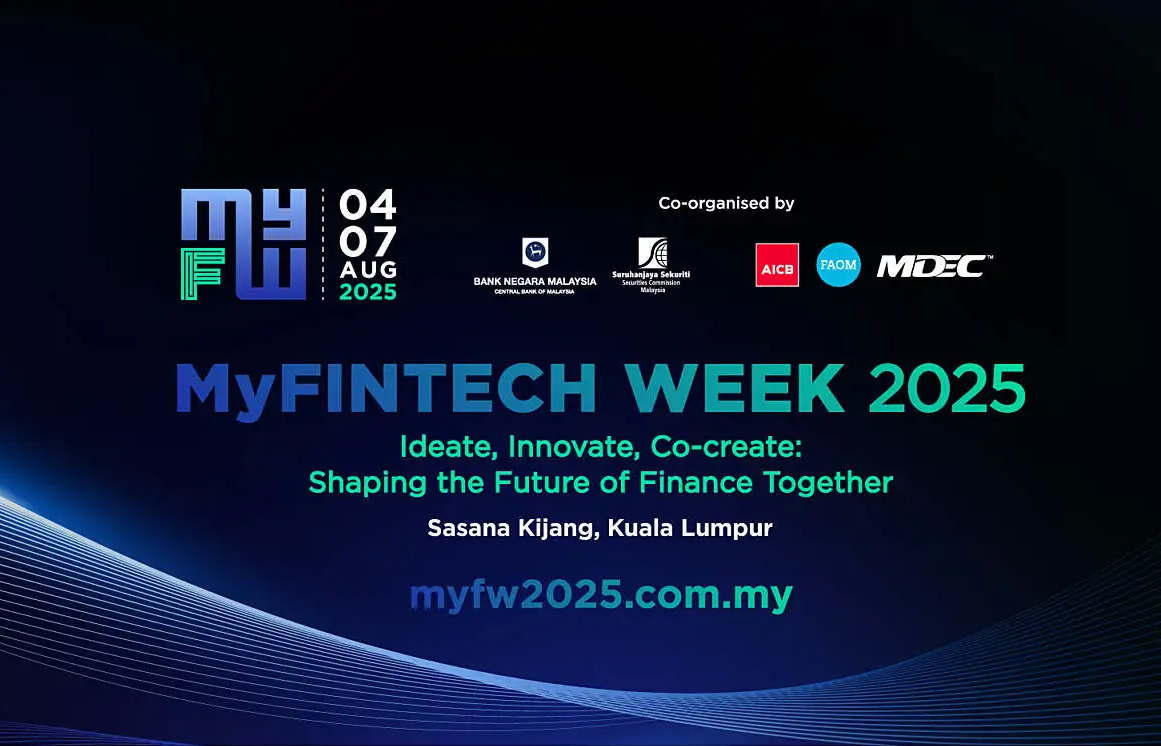Ethical Finance ASEAN 2025
The AICB and the Global Ethical Finance Initiative (GEFI) hosted the Ethical Finance ASEAN 2025 virtual summit on 19 February 2025, drawing over 2,000 delegates from across the region, including leading government officials, captains of industry, and practitioners. Discussions with 30 international experts centred on the theme of ‘Driving Inclusivity and Sustainability’, which covered key topics such as inclusive growth, climate finance, green innovation, and ASEAN’s global role in economic resilience. In a first for Kuala Lumpur, AICB and GEFI — with the Malaysia International Islamic Financial Centre (MIFC) Leadership Council and MBSB Bank — co-hosted an exclusive pre-summit private session on 18 February 2025: the Ethical Finance ASEAN SDG Hive, a half-day in-person programme addressing the summit’s core themes.

MyFintech Week 2025
From 4 to 7 August 2025, Kuala Lumpur will host a powerful gathering of global visionaries, regulators, tech pioneers, and financial institutions shaping the digital finance ecosystem.
The premier fintech event is co-organised by Bank Negara Malaysia (BNM), Securities Commission Malaysia, Asian Institute of Chartered Bankers, Fintech Association of Malaysia, and Malaysia Digital Economy Corporation.

The four-day event at the BNM’s centre of excellence, Sasana Kijang, will feature curated masterclasses, innovation showcases, hackathons, roundtables, and insight-packed sessions on artificial intelligence in banking, digital currencies, regulatory technology, insurance, capital markets, green fintech, and sustainability.
Be part of the conversations shaping policy, innovation, digital transformation, and the future of finance in Asia.
Register now at myfw2025.com.my
Emerging Economies Turn the Tides to Stay On Course
Headwinds abound as emerging markets and developing economies step into the second quarter of the 21st century, says the World Bank Group, and a reprioritisation is necessary for countries to continue on their trajectory of growth and development.
Based on data released in its flagship Global Economic Report this year, the international financial institution finds that “progress implementing structural reforms in many of these economies has stalled” amid rising global protectionist measures and geopolitical fragmentation.
Key policy interventions can turn the tide for these emerging economies, potentially converting challenges into new opportunities by:
- Improving growth prospects in order to boost investment and productivity. This is achieved through: (i) accelerated investments, particularly in infrastructure; (ii) improved business climate to boost private investment growth, spur innovation, and the diffusion of technology; (iii) further action to enhance human capital, setting the stage to boost labour productivity.
- Navigating a difficult external environment. This includes multiple elements, including but not limited to: (i) seeking strategic trade and investment partnerships with rapidly expanding economies and markets, including other developing economies; (ii) tackling high trade costs and low trade efficiency; (iii) pursuing avenues to diversify trade and making wise use of industrial policy; (iv) putting in place policies to protect vulnerable segments of society from adverse effects of trade-related policy changes; and (v) reinvigorating engagement in global trade governance in order to achieve global cooperation and solutions.
- Enhancing macroeconomic stability. Strengthening macroeconomic stability is key in maintaining investor confidence and managing systemic risks. In the past 25 years, accumulated buffers and policy improvements implemented in the period preceding the global financial crisis allowed many of these economies to use countercyclical policies to mitigate its impact. With the sluggish global growth outlook and high risk of external shocks, it is imperative that developing economies strengthen their fiscal cushions and frameworks. Significant and wide-ranging policy reform efforts — drawing on experience gained in many countries — could promote an acceleration of investment that could help reverse the projected decline in potential growth expected in developing economies during the coming years.
New EU AML Chief Sets Tone for Intelligence Sharing
In February 2025, the EU’s nascent anti-money laundering (AML) regulatory agency, known as the Anti-Money Laundering Authority or AMLA, appointed veteran Italian central banker, Bruna Szego, as its first Chair.
First mooted in 2021, the new Frankfurt-based agency fulfils a dual role as both AML supervisor and data-sharing hub for national financial intelligence units for the EU. Taking over the AML duties of the European Banking Authority, AMLA has been regularly meeting with national supervisors of the 27-country bloc as part of forthcoming overhauls to the supervisory architecture.

In an exclusive interview with compliance portal ACAMS moneylaundering.com, Szego said that beginning in 2028, the agency will directly oversee 40 of the economic bloc’s riskiest financial institutions as measured by their systemic importance and exposure to illicit finance.
She said: “We should not focus only on few financial sectors, but rather select the financial institutions that bear the highest inherent and residual risk [while] looking at a broader range of sectors…This appears to me more in line with the AMLA framework, and would allow AMLA to have a better grip on risks…and to raise standards more widely.”
The move is in sync with the European Banking Authority’s recently proposed regulatory technical standards (RTS) related to anti-money laundering and countering financing of terrorism (AML/CFT). The latest four RTS drafts are in the consultation phase until 6 June 2025.
In earlier versions of the RTS, the news portal reported of industry concerns that “large banks would receive the lion’s share of the new agency’s attention despite the outsized role of smaller lenders, fintechs and cryptocurrency platforms in recent money-laundering scandals.” The RTS’ final form will standardise and shape how EU institutions are expected to comply with AML/CFT obligations.
Are Cross-border Crypto Flows DeFiying Gravity?
In DeFiying Gravity? An Empirical Analysis of Cross-border Bitcoin, Ether and Stablecoin Flows, released in May, BIS researchers Raphael Auer, Ulf Lewrick, and Jan Paulick investigate the trends and drivers of cross-border cryptocurrency (crypto) transactions in order to shed light on this burgeoning asset class and its impact on financial resilience.
 Surveying up to 184 countries from 2017 to 2024, the data set maps the bilateral flows of the two most-traded cryptocurrencies (bitcoin, ether) and the two largest stablecoins by market capitalisation (tether, USD coin). These heterogeneous cryptoassets are created on the blockchain; however, digital assets like bitcoin and ether are subject to price fluctuations as these are not backed against any other external asset, whilst stablecoins are pegged 1:1 to either fiat currency or a commodity such as gold.
Surveying up to 184 countries from 2017 to 2024, the data set maps the bilateral flows of the two most-traded cryptocurrencies (bitcoin, ether) and the two largest stablecoins by market capitalisation (tether, USD coin). These heterogeneous cryptoassets are created on the blockchain; however, digital assets like bitcoin and ether are subject to price fluctuations as these are not backed against any other external asset, whilst stablecoins are pegged 1:1 to either fiat currency or a commodity such as gold.
Using a gravity framework to identify significant drivers of cross-border crypto flows, the analysis uncovers important differentiating factors affecting the network of directional bilateral flows between countries:
- Compared to traditional financial flows across borders and its determinants, there is a diminishing significance of geographical proximity in crypto flows, particularly for stablecoins, which appear to largely ‘defy’ these traditional frictions.
- Tighter global funding conditions, known to curtail risk-taking in traditional asset classes, are associated with reduced flows. This indicates increasing interconnectedness between cryptoassets as speculative assets and mainstream finance.
- Market-specific risk factors alongside heightened public awareness of cryptoassets are strong drivers of crypto flows, illustrating cryptoassets’ role in speculation.
- Our analysis points to cryptoassets also being used as a transactional medium. This is most apparent for stablecoins and low-value bitcoin payments. Higher opportunity costs of fiat currency usage, such as high inflation, spur bilateral cross-border transactions in both unbacked cryptoassets and stablecoins.
- Greater economic activity within both sender and receiver countries is often linked to increased crypto flows in most cases.
- High costs of remittance payments through traditional financial intermediaries are associated with significantly larger cross-border flows in stablecoins and low-value bitcoin payments from advanced economies to emerging and developing markets.
- Capital flow management measures targeting the reduction of outflows from the sender country and the limitation of inflows into the recipient country have little impact on crypto flows. Indeed, capital flow management may even correlate with an increase in cross-border flows of some cryptoassets, hinting at circumvention.
The paper is an important extension of the literature on international capital flows as the use cases of cryptoassets widens, particularly in emerging and developing economies.